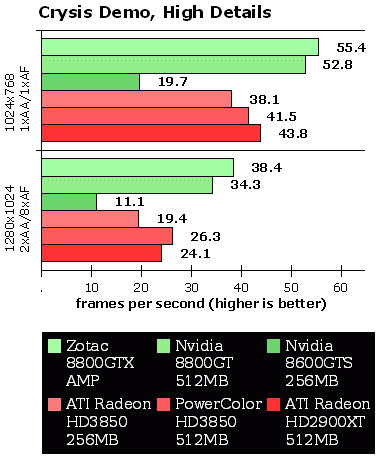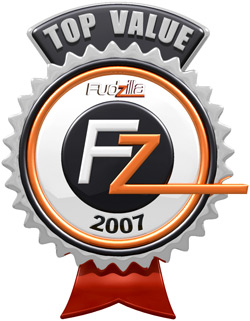Here are the results in a few currently popular games, and they aren't quite what we expected. Geforce 8800 GT is quite popular, and we are mighty curious as to what ATI’s cards can do. Sadly, we didn’t manage to get an HD 3870, so HD3850 is alone by itself in these tables, and compared to Geforce 8800 GT its results don’t look good. Yes, this comparison is quite unfair, but 8800 GT 256MB is virtually impossible to find at this point. However, as we’ve seen many times before, the performance gap between 256MB cards and their 512MB colleagues is not that great, so HD3850 competing against Geforce 8800 GT 256MB is quite unlikely.
Company of Heroes ( Opposing Fronts )

Power Color HD 3850 beats ATI’s reference card by 15 percent, on all resolutions, but loses to HD 2900XT by about 10 percent. Power Color did a good overclocking job, and it definitely improved HD 3850’s low scores. Compared to HD 2900XT, the reference card loses by over 25 percent. Resolution of 2048x1536 allows for pleasant gaming, although 8800 GT beats Power Color HD 3850 by 56 percent.
F.E.A.R.

F.E.A.R. is the only game where performance gaps are minimal. At 2048x1536, Power Color loses to 8800 GT by 18 percent and to HD 2900XT by 12 percent. Again we see a good effort by the overclocked card, which beats the reference card by 18 percent. 39fps enables for problem free gaming.
S.T.A.L.K.E.R.

Power Color HD 3850 constantly beats the reference design by 13 percent, but it loses to HD 2900XT by the same margin. You can see that Power Color’s card performs well, and that it churns out more than enough fps for regular gaming. We used maximum detail in all the games, and even that wasn’t enough to take HD 3850 down.
World In Conflict
We’re used to seeing high-end cards handling the games well, but that, it seems, is in the past. In World in Conflict, we used maximum details, but the results are so bad that it’s not worth even talking about.

In this test, Nvidia overran ATI. New drivers would probably make HD 3850 scores higher, but we only had the Beta driver. Although Power Color HD 3850 performs poorly at 2048x1536, it’s still 55 percent better than ATI’s reference card.
Crysis

Conclusion
With their new generation of cards based on RV670, ATI brought a couple of new features, as well as some improvements to R600 design, such as high power consumption and a hot processor. The new 55nm chip runs much cooler and saves power, especially now that PowerPlay is here. We can’t forget the ZEROtherm cooler that easily outperforms ATI’s reference coolers.
One more novelty is PCI Express 2.0 with double the standard bandwidth. You probably won’t need it any time soon, but it won’t hurt. Unlike 8800 GT, the card supports DX10.1, but we won’t reap the rewards until the Vista service pack arrives.
Power Color HD 3850 Extreme PCS is a prince of HD 3850 generation. The core runs at 720MHz and the memory at 900MHz. The card itself is faster than reference card by 15 percent. Another cool thing that greatly improved this card’s score is the fact that it packs double the memory of reference cards. We’re talking about 512MB GDDR3 memory, compared to reference 256MB.
HD 3850 Extreme enables flawless gaming, but higher resolutions with antialiasing on prove to be a bit of a challenge for RV670. If you’re looking for HDMI capabilities, then look no further – Power Color HD 3850 Extreme PCS is THE card for HDMI. It’s unlikely that you’ll find another card with native HDMI connector in this price range. UVD is implemented so High Definition content is a piece of cake for HD 3850 Extreme card.
The price is still unknown, but since the reference PowerColor HD 3850 256MB is priced at €143, we’re expecting the price to be around €165, which is still very reasonable for a card in this class; so, the HD 3850 series gets our Top Value award.

